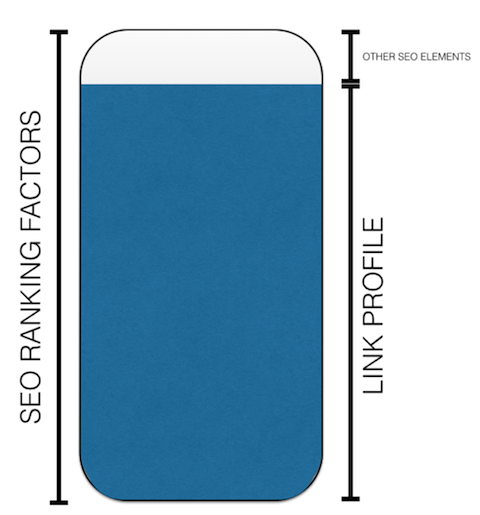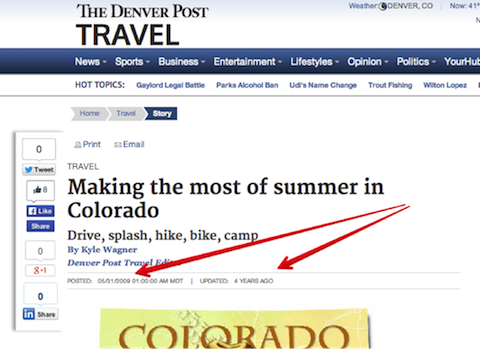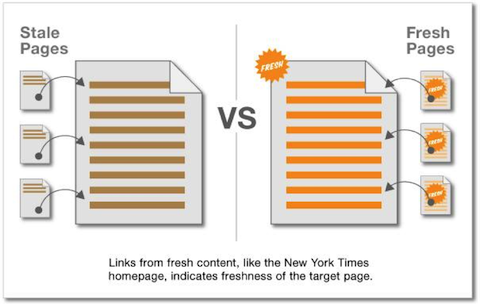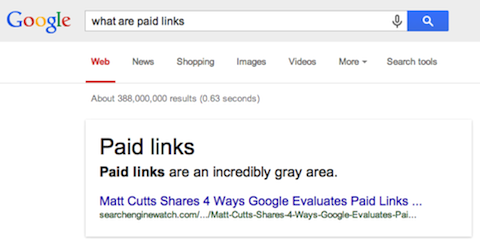You know that good back links are an important part of SEO. You know how important it is to work at building strong backlinks. You understand the impact of over-optimized anchor text. You realize the toxic effect of links from spam sites and directory listings. But how important is it, really? And, more to the point, how can you get a link profile that Google loves?
We want to explain the components of a “good link profile” and provide suggestions for how you can improve your link profile.
The importance of a link profile for SEO
In order to stress this point, we want to show you just how important your link profile is.
2013 was a big year in SEO with the rollout of Penguin 2.0, the introduction of Hummingbird, and the announcement, right after the New Year, that social signals are not factored into the search algorithm.
Where do all these changes leave us when it comes to the importance of a link profile?
Ten years later, it’s still really important.
Based on testing, consultation with other industry experts, and careful analysis of existing data, we’ve come up with a visual representation of how important, we think, a website’s link profile is:

(If you want more detailed information on possible ranking factors, please see the Moz’s list of ranking factors.)
We don’t know for sure, but based on careful study, testing, and experience, we think it’s safe to say that a link profile accounts for the vast majority of a site’s ranking according to Google’s algorithm.
The penalties that Google gives to sites are largely based on the sites’ link profiles. The issues that most directly impact a site’s positive ranking are integrally connected to the link profile of that site.
A link profile is incredibly important, which means we need to be asking the following questions:
What is a good link profile?
and
How do I get one?
What Is a Good Link Profile?
So, let’s answer the first question.
First, let us point out what a good link profile is not. It’s not just backlinks.
Any SEO will tell you that backlinks are the most important element of SEO. Real ranking goes nowhere unless there are backlinks.
However, you can’t simply pore over the backlinks and neglect the larger picture of what’s going on with your link profile. A link profile is more than just backlinks.
Stated another way, backlinks are just one component of the link profile. There is a deeper complexity to the backlink discussion.
So, let’s go through several other things that affect a link profile. What follows is a discussion of the features that characterize a healthy link profile. This is not an exhaustive list.
Big Idea: a good link profile has lots of high authority links and no spammy links.
In other words, there are two overarching qualities to a good link profile:
- Lots of high value, high DA, and high authority linkbacks.
- No spammy backlinks.
You already knew that. We want to go further and explain some of the less obvious features of a good link profile.
Branded anchor text
When you break down the importance level of the different elements that affect a website’s ranking, it looks like this:
- Most important factor in a website ranking: Link profile.
- Most important aspect of a link profile: Quality of backlinks.
- Most important quality aspect of backlinks: Anchor text.
- Most important quality of anchor text: Diversity.
Google wants to see in a link profile anchors that display diversity in the form of branded anchor texts.
A branded anchor text is one in which the anchor includes the brand name of the company.
For example, if your company is Better World Electronics, then a branded anchor would be “Better World Electronics,” and it would point to your URL.
Branded anchors may also be diluted or combined with keywords.
- Diluted: “This company, known as Branded World Electronics, or BWE, is a leading provider of wearable electronic devices.”
- Combined with keywords: “One device, Better World Electronic’s wearable heart rate monitor, is surprisingly affordable.”
A good link profile can contain a large percentage of such anchors. In some cases, this percentage might be as high as 20% of total anchor texts without any damage being done to the site’s link profile.
Semantically relevant anchor text
Another type of diverse anchor text is “semantically relevant.”
You’re probably familiar with Google’s semantically related keywords. Google may return your website in queries even if those queries do not include your target keyword as long as the content on your website is similar to the keywords that are used in the query.
When you have in your link profile anchors that use such semantically similar keywords, this helps to enrich and diversify the profile.
A semantically relevant anchor may look like this:
- Your target keyword: “wearable heart rate monitor”
- Semantically relevant anchor: “smart fitness tracking device”
Your website may have a blog article on the subject of “Wearable Heart Rate Monitors Used for Olympic Marathon Training.” A health website then links to this page, using the anchor “smart fitness tracking device.” This type of semantically relevant anchor text can help enhance a link profile.
Diluted anchor text
We mentioned the word “diluted” above, referring to a branded anchor combined with other words or phrases. This is an important feature of healthy link building.
In the post-Penguin era of link building, optimized anchor texts are bad. Diluted anchor texts are good.
A diluted anchor text is one in which the anchor text has lots of words, some related and some not.
For example, let’s use our fictional example of Better World Electronics, who wants to rank for keywords that have to do with fitness tracking devices, wearable electronics, wearable heart rate monitors, etc.
A nice diluted anchor text linking to its site would look like this: “Want to wear a heart rate monitor while you sleep? Some companies are making this possible.” (Underlined portion is the anchor text.)
That’s a whole sentence worth of anchor text. It doesn’t contain any keywords. And it doesn’t even contain the brand name. But that’s okay. Its dilution makes it a valuable link to have in the link profile as long as all other factors are positive.
The more diverse, random, and diluted an inbound link profile is, the better.
Relevancy of linking site
This component is also known as local/topic-specific popularity. As an algorithmic feature, it was initially developed by Teoma, which is now rebranded and integrated into Ask.com. It is now a standard part of virtually every search engine’s algorithm.
Your site’s backlinks should ideally come from sites with a similar topic. They need to be relevant.
For example, let’s say you have a site that has to do with online real estate accounting. You receive a backlink from a landscape management company. This link from the landscaping company will not do much to enhance your link profile. If, however, you received a backlink from Realty.com, this would be far more beneficial to your link profile.
Realty has to do with real estate, just like your site does. Landscaping — not so much. You want links from sites in your niche.
Relevancy of surrounding context
Relevancy goes a bit deeper though. A healthy link profile has links with a relevant content, surrounding the anchor.
Let’s go back to the online real estate accounting company and its link from Realty.com. I will contrast two examples of a link:
Example 1: The Realty.com link comes from a page that features an article titled “Best Ways to Stage a Manor House for Real Estate Photography.” The link to your real estate accounting site comes from a paragraph about placing furniture in front of wall vents. This is an irrelevant discussion to your core business and likely to the content on your site. The link, while it will probably help your site, is not the most ideal.
Example 2: The Realty.com link comes from a blog article “Top Ten Online Real Estate Accounting Software Services.” The link to your business is in a paragraph that is about your business specifically. The anchor is a branded anchor that goes to one of your blog articles. Gold. This is a perfect link.
When a sending link has a surrounding discussion that is closely related to your niche, this increases the value of that link to your profile.
Vicariously compromised linking site
Let us explain what I mean by “vicariously compromised linking site.” It sounds kind of jargony at first.
This happens when you get a link from a site that is, on its own account, not a spam site. This very site, however, links to a spam site and has spam links pointing to it. It is vicariously compromised.
In the algorithm’s eyes, the link you get from that site is in a “bad neighborhood.” This guilt by association lowers the value of the link. It also has toxic links pointing to it. The distributed value of these toxic links is then transferred to your site.
Freshness of links
As time goes on, the power of a link tends to decline. If you have a link from a DA 90 site that is seven years old, it may not be delivering the same amount of value as a DA 80 site that just linked yesterday.
Here is an example. The site beavercreekresortproperties.com has a link from The Denver Post:

The Denver Post has high domain authority of 89. But the link comes from an article that is several years old:

While not devaluing the site, this link is no longer providing the same level of value that it did when it first occurred.
This phenomenon is dubbed as Google’s Freshness Factor. We know that a page’s content can get “stale” over time and fall in rank.
Links, like content, also get stale and provide lesser value over time. Here’s how Moz illustrates the influence of value of links from fresh sites:

There is a legion of other factors that influence Google’s Freshness Factor. We recommend Cyrus Shephard’s excellent treatment of the subject.
The fresher the link, the more value it adds.
Co-citation and co-occurrence
Strictly speaking, co-citation is not a link. It does, however, register tangentially in the taxonomy of link profiles. Co-citation, often used interchangeably with the term co-occurrence, is the mere mention of site A by site B, even without an actual anchor/link between the two. Value is passed from one to the other as a result of the mention.
For example, let’s say your company Awesome Real Estate Accounting Software is discussed in the New York Times. There is no link, but there’s your company name — Awesome Real Estate Accounting Software. This is a good thing even if there is no link.
It goes a step further though. Sites pass additional co-citation authority when they contain contextual keywords and contextual links to high authority sites. Let’s say that you receive a link from a site, and that site, in turn, is mentioned in co-occurrence by a high-value site. This one-step-removed co-citation may actually improve the value of the link to your site.
Authority of the linking site
This is an obvious one. I’m going to add a brief discussion on nofollow though.
When your site receives a link from a high authority site, your site gets major value.
In order to be truly effectual, the link should be a followed link rather than a link with the tag “nofollow.” A nofollow link still has some value, but it’s not the value that contributes to the link profile.
When Google comes across a link to your site with the nofollow tag, here’s what it does:
In general, we don’t follow them. This means that Google does not transfer PageRank or anchor text across these links. Essentially, using nofollow causes us to drop the target links from our overall graph of the web.
You can find out if a link is “nofollow” by going to a page source code and looking at the link’s href tag.
Wikipedia, as a rule, nofollows all links. Here’s its page on Google, with the link to a page in Google.com:

Thus, the Wikipedia link doesn’t pass any rank or value to Google. (Not that it really needed it anyway.)
The depth of the linked page
The deeper the link goes into a website’s structure, the more valuable it is in a link profile.
It’s a fact of linking: most links your site receives point to your homepage — the first level in the structure of your website.
However, an over-saturation of links to a homepage will not be as valuable as when those links are balanced by a number of other links going to deep internal pages on the website.
Your deep internal pages need to be strengthened with backlinks. When they receive such backlinks, they enhance the authority of the site as a whole.
This is one of the reasons why you need to have strong content marketing. Content lives on pages that are deep within a site’s structure, providing linkable value for those internal pages.
The diversity of the linked pages
A good link profile will display lots of linked pages. It won’t just have links to one or two pages but will display links to the Homepage, the Blog page, the About Us page, the Contact Page, and other subpages.
The broader the distribution and diversity of linked pages, the stronger the link profile.
No paid links
Paid links are spam, plain and simple.
To see a humorous display of Google’s Knowledge Graph search results on paid links, try Googling “what are paid links.”
Here’s what you might see:

It’s not really gray. It’s black, especially when those paid links are obvious.
Cutts knows:
The vast majority of the time things are incredibly clear: people are paying money outright for links based on PageRank, flowing the PageRank, trying to get high the rankings. Ninety-nine percent of the time it’s abundantly clear that these are links that are being bought and paid and sold and all that sort of stuff.
There are, admittedly, gray areas. Obviously, the algorithm doesn’t know if you buy the link-giver lunch in exchange for the link.
Generally speaking, however, when the algorithm can determine the presence of paid links in your inbound link profile, it will come wielding a penalty hammer.
Number of links to a page
The more links a page receives, the better. A healthy link profile, after all, has lots of link-backs.
But what about getting lots of links from the same site? Do more links from the same site add value?
No.
Google reads one link from a site in much the same way as it reads tons of links from that site. So, if you get a link from hbr.org, that’s awesome.
If you get twenty links from www.hbr.org, does that mean you get twenty times the awesomeness?
Not quite. What you want is lots of links, yes. But you want lots of links from different sites.
Lots of links from the same site won’t hurt your link profile. It just won’t help you.
No article directory links
Great link profiles don’t have spammy directory listings. It is fairly common knowledge in the SEO industry that article directory links are dangerous territory.
Cutts himself recently made the statement again, saying that you shouldn’t use article directories to build links. He even went so far as to discuss it in a video.

Back in the good ol’ days of SEO, it was relatively easy to spawn off a few dozen articles on an article directory site and get a nice SEO kickback. Today, not so much.
We recommend that companies whose link profile is bloated with such links go into the article directory itself and remove the links.
Conclusion
So, how do you get a good link profile? Now that you understand the features of a great inbound link profile, you should have a better idea of what strategy to employ to acquire links.
Here’s our simple advice. Do a darn good job at content marketing.
If you have a strong content marketing strategy rather than an explicit link acquisition strategy, then the links will come. They will be stronger, healthier, and more reputable than you could possibly guarantee by engaging in some not-so-sure-if-it’s-gonna-work link building strategy.
Content marketing is SEO, and it’s a very powerful and transformative way of doing it.
